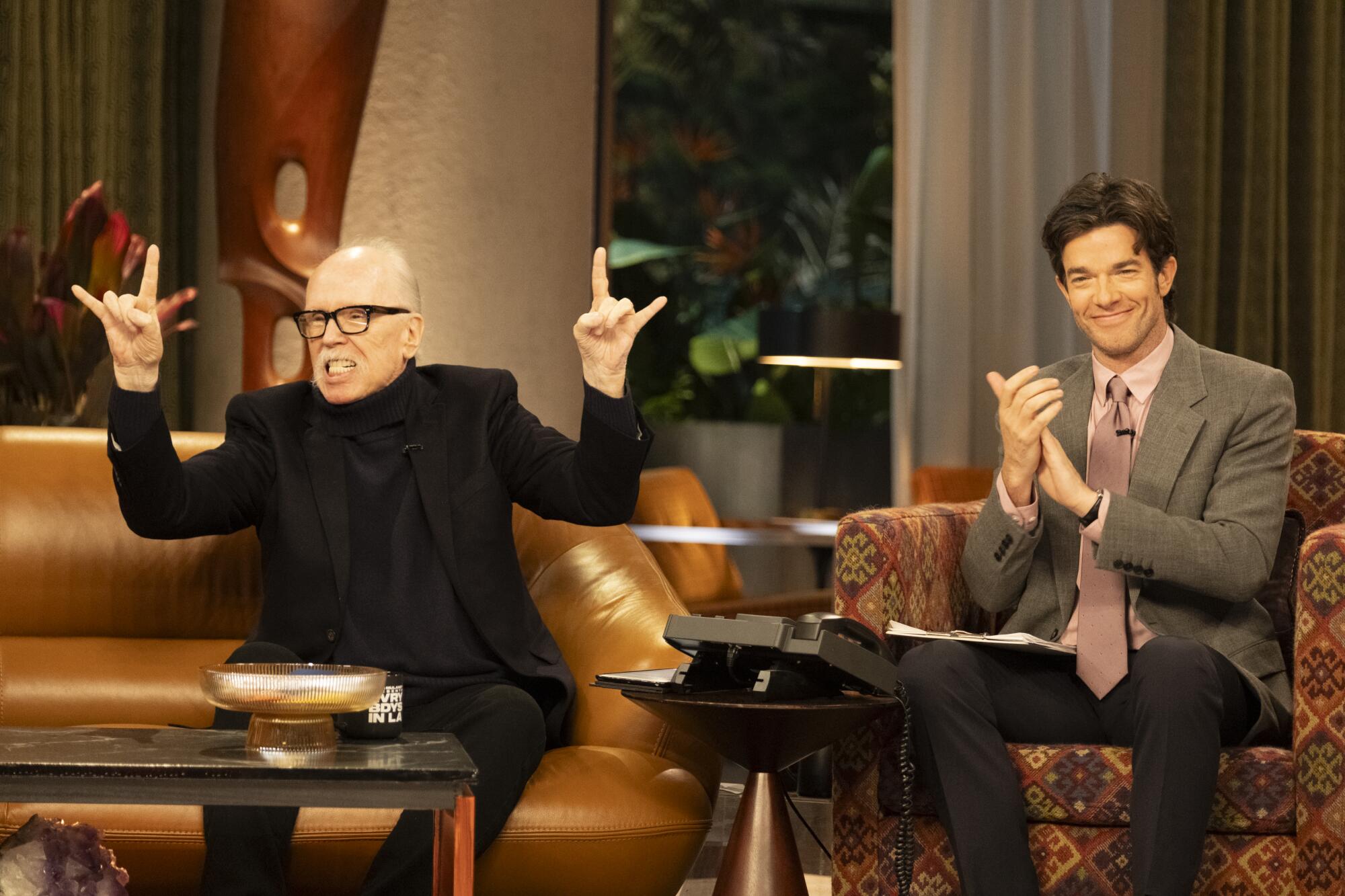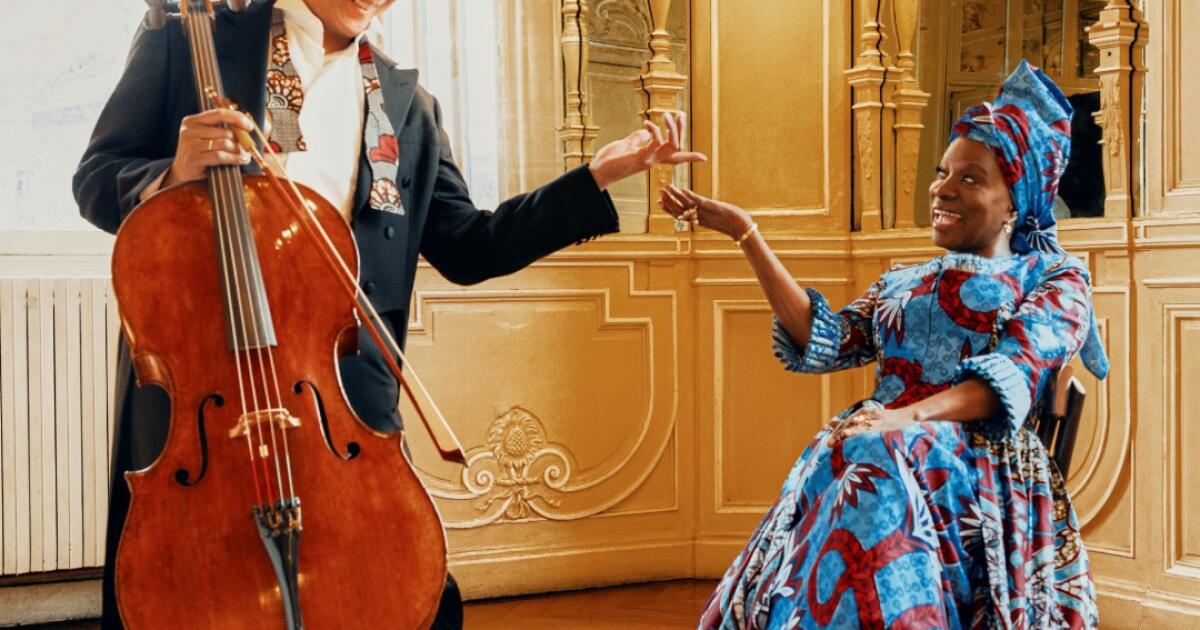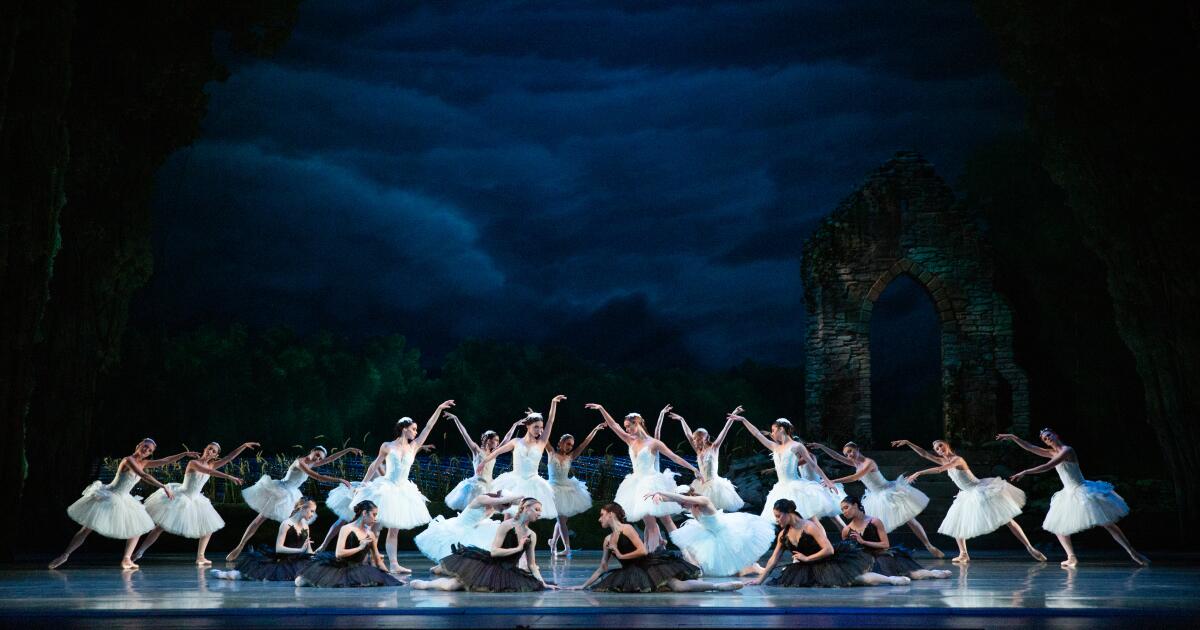John Carpenter is long overdue for praise. He’s happy to play the hits
John Carpenter has this one recurring nightmare.
“I’m in a huge, massive town I don’t really know,” he says, “and I’m looking for the movie district. And inevitably all the theaters are closed down. They’re all closed down. That’s what the dream is.”
I’m visiting Carpenter at his longtime production house in Hollywood on one of L.A.’s unjustly sunny October afternoons. A vintage “Halloween” pinball machine and a life-size Nosferatu hover near his easy chair. I tell him I don’t think Freud would have too much trouble interpreting that particular dream.
“No, I know,” he says, laughing. “I don’t have too much trouble with that either.”
Nonetheless, it truly haunts him — “and it has haunted me over the years for many dreams in a row,” he continues. “I’m either with family or a group, and I go off to do something and I get completely lost. [Freud] wouldn’t have too much trouble figuring that out either. I mean, none of this is very mysterious.”
Carpenter is a gruff but approachable 77 these days, his career as a film director receding in the rearview. The last feature he made was 2010’s “The Ward.” His unofficial retirement was partly chosen, partly imposed by a capricious industry. The great movie poster artist Drew Struzan died two days before I visited — Carpenter says he never met Struzan but loved his work, especially his striking painting for the director’s icy 1982 creature movie “The Thing” — and I note how that whole enterprise of selling a movie with a piece of handmade art is a lost one.
“The whole movie business that I knew, that I grew up with, is gone,” he replies. “All gone.”
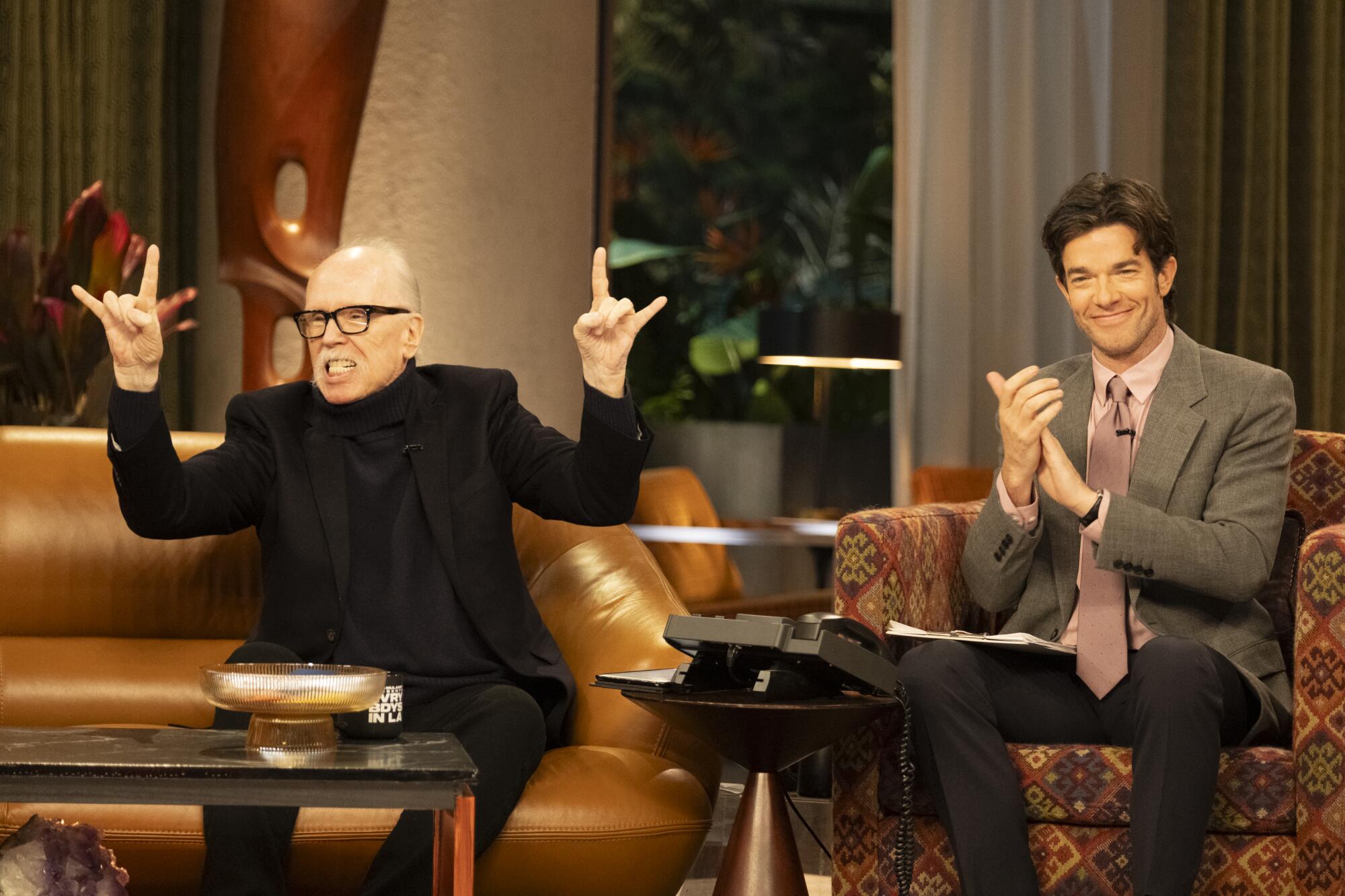
John Carpenter with John Mulaney, appearing as a part of “Everybody’s in L.A.” at the Sunset Gower Studios in May 2024.
(Adam Rose / Netflix)
It hasn’t, thankfully, made him want to escape from L.A. He still lives here with his wife, Sandy King, who runs the graphic novel imprint Storm King Comics, which Carpenter contributes to. He gamely appeared on John Mulaney’s “Everybody’s in L.A.” series on Netflix and, earlier this year, the Los Angeles Film Critics Assn. gave him a Career Achievement Award — a belated lovefest for a veteran who was sidelined after “The Thing” flopped, cast out into indie darkness and was never personally nominated for an Oscar.
The thing that does keep Carpenter busy these days (other than watching Warriors basketball and playing videogames) is the thing that might have an even bigger cultural footprint than his movies: his music. With his adult son Cody and godson, Daniel Davies, Carpenter is once again performing live concerts of his film scores and instrumental albums in a run at downtown’s Belasco this weekend and next.
The synthy, hypnotic scores that became his signature in films like “Halloween” and “Escape from New York” not only outnumber his output as a director — he’s scored movies for several other filmmakers and recently made a handshake deal in public to score Bong Joon Ho’s next feature — but their influence and popularity are much more evident in 2025 than the style of his image-making.
From “Stranger Things” to “F1,” Carpenter’s minimalist palette of retro electronica combined with the groove-based, trancelike ethos of his music (which now includes four “Lost Themes” records) is the coin of the realm so many modern artists are chasing.
Very few composers today are trying to sound like John Williams; many of them want to sound like John Carpenter. The Kentucky-raised skeptic with the long white hair doesn’t believe me when I express this.
“Well, see, I must be stupid,” he says, “because I don’t get it.”
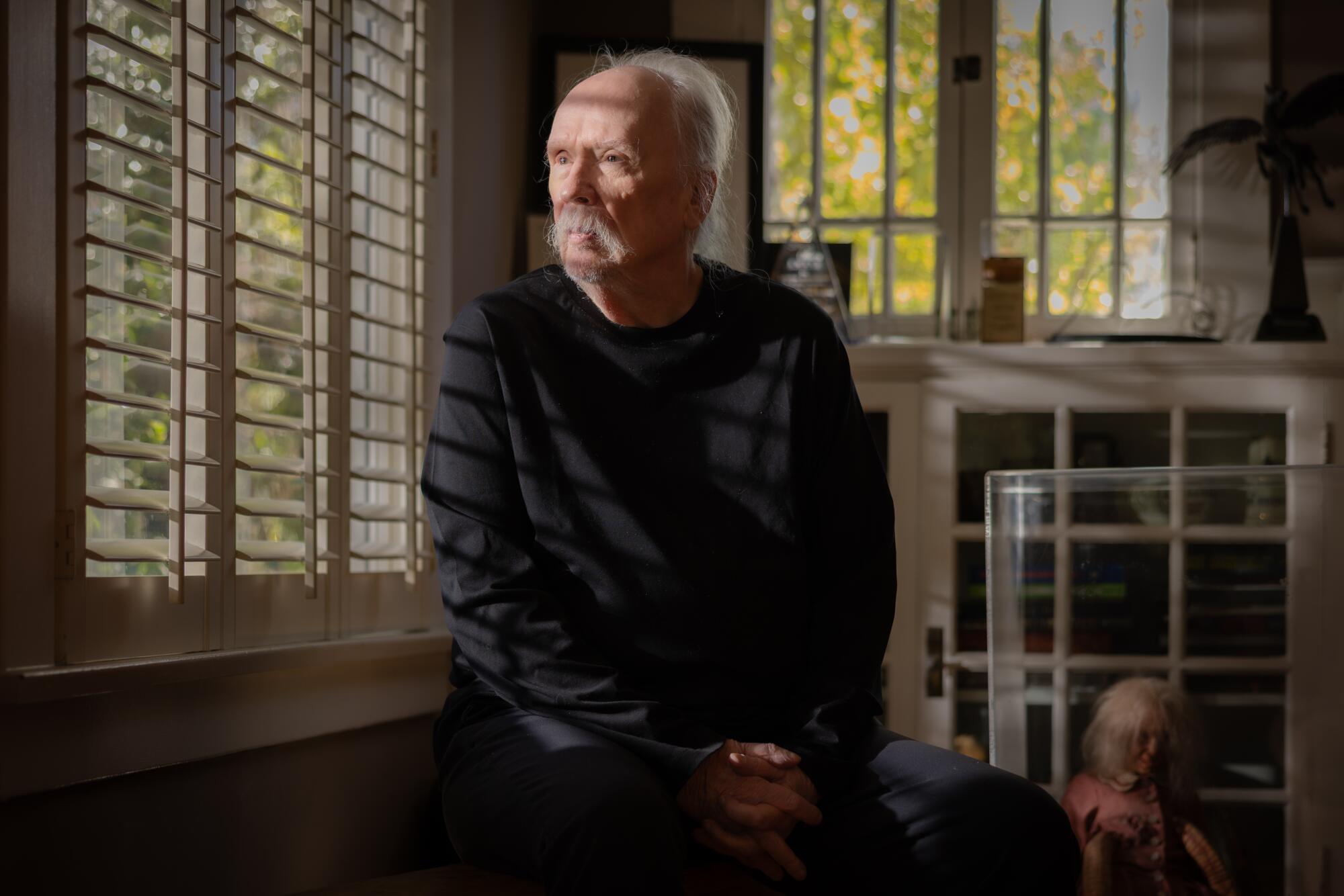
“The true evil in the world comes from people,” says Carpenter. “I know that nature’s pretty rough, but not like men.
(Jason Armond / Los Angeles Times)
Carpenter is quick to put himself down. He always says that he scored his own films because he was the only composer he could afford, and that he only used synths because they were cheap and he couldn’t properly write music for an orchestra. When I tell him that Daniel Wyman, the instrumentalist who helped program and execute the “Halloween” score in 1978, praised Carpenter’s innate knowledge of the “circle of fifths” and secondary dominants — bedrocks of Western musical theory that allowed Carpenter’s scores to keep the tension cooking — he huffs.
“I have no idea what he’s talking about,” Carpenter says, halfway between self-deprecation and something more rascally. “It all comes, probably, from the years I spent in our front room with my father and listening to classical music. I’m sure I’m just digging this s— out.”
Whether by osmosis or genetics or possibly black magic, Carpenter clearly absorbed his powers from his father, Dr. Howard Carpenter, a classically trained violinist and composer. Classical music filled the childhood home in Bowling Green and for young John it was all about “Bach, Bach and Bach. He’s my favorite. I just can’t get enough of Johann there.”
It makes sense. Bach’s music has a circular spell quality and the pipe organ, resounding with reverb in gargantuan cathedrals, was the original synthesizer.
“He’s the Rock of Ages of music,” says Carpenter, who particularly loves the fugue nicknamed “St. Anne” and the Toccata and Fugue in D Minor. “Everybody would go back to Mozart or Beethoven. They are astonishing — Beethoven is especially astonishing — but they’re not my style. I don’t feel it like I do with Bach. I immediately got him.”
Carpenter was also a film score freak since Day 1. He cites the early electronic music in 1956’s “Forbidden Planet” and claims Bernard Herrmann and Dimitri Tiomkin as his two all-time favorites. Just listen, he says, to the way Tiomkin’s music transitions from the westerny fanfare under the Winchester Pictures logo to the swirling, menacing orchestral storm that accompanies “The Thing From Another World” title card in that 1951 sci-fi picture that Carpenter remixed as “The Thing.”
“The music is so weird, I cannot follow it,” he says. “But I love it.”
Yet Carpenter feels more personally indebted to rock ‘n’ roll: the Beatles, the Stones, the Doors. He wanted to be a rock star ever since he grew his hair long and bought a guitar in high school. He sang and performed R&B and psychedelic rock for sororities on the Western Kentucky campus as well as on a tour of the U.S. Army bases in Germany. He formed the rock trio Coupe de Villes with his buddies at USC and they made an album and played wrap parties.
He also kept soaking up contemporary influences, listening to Warren Zevon’s “Werewolves of London” while location scouting for “Halloween.” Peter Fonda later introduced Carpenter to Zevon and he wanted the director to adapt the song into a film that never happened (starring Fonda as the werewolf, but “this time he gets the girl,” Carpenter recalls). In the ’80s he blasted Metallica with his two boys and he still loves Devo.
It’s incredibly rare for a film director to score their own films, rarer still for one to spend decades on stage as a performing musician. The requisite personalities would seem diametrical.
“My dad was a performing musician, so it was just part of the family,” Carpenter says. However, until 2016, when Carpenter first toured with his music, he was consumed with stage fright. “I had an incident when I was in a play in high school,” he says. “I went up and I forgot my lines. Shame descended upon me and I had a tough time. I was scared all the time.”
The director credits his touring drummer, Scott Seiver, for helping him beat it.
“Your adrenaline carries you to another planet when that thing starts,” he sighs with pleasure. “You hear a wall of screaming people. It’s a big time.”
He pushes back against the idea that directors “hide behind the camera.”
“The pressure, that’s the biggest thing,” Carpenter says. “You put yourself under pressure from the studio, you’re carrying all this money, crew, you want to be on time.”
He remembers seeing some haggard making-of footage of himself in post-production on “Ghost of Mars” in 2001 and thinking: Oh my God, this guy is in trouble. “I had to stop,” he says. “I can’t do this to myself anymore. I can’t take this kind of stress — it’ll kill you, as it has so many other directors. The music came along and it’s from God. It’s a blessing.”
John Carpenter is grateful but he doesn’t believe in God. He believes that, when we die, “we just disperse — our energy disperses, and we return to what we were. We’re all stardust up there and the darkness created us, in a sense. So that’s what we have to make peace with. I point up to the infinite, the space between stars. But things stop when you die. Your heart stops, brain — everything stops. You get cold. Your energy dissipates and it just… ends. The End.”
This is not exactly a peaceful thought for him.
“I mean, I don’t want to die,” he adds. “I’m not looking forward to that. But what can you do? I can’t control it. But that’s what I believe and I’m alone in it. I can’t put that on anybody else. Everybody has their own beliefs, their own gods, their own afterlife.”
He describes himself as a “long-term optimist but a short-term pessimist.”
“I have hope,” he says, “put it that way.” Yet he looks around and sees a lot of evil.
“The true evil in the world comes from people,” says Carpenter, who has long used cinematic allegories to skewer capitalist pigs and bloodthirsty governments. “I know that nature’s pretty rough, but not like men. You see pictures of lions taking down their prey and you see the face of the prey and you say: ‘Oh, man.’ Humans do things like that and enjoy it. Or they do things like that for power or pleasure. Humans are evil but they’re capable of massive good — and they’re capable of the greatest art form we have: music.”
The greatest?
“You don’t have to talk about it. You just sit and listen to it. It’s not my favorite,” he clarifies, alluding to his first love, cinema — “but it’s the one that transcends centuries.”
Music has always been kinder to him than the movie business. That business recently reared its ugly head when A24 tossed his completed score for “Death of a Unicorn.” (At least he owns the rights and will be putting it out sometime soon.) In addition to the high he gets from playing live, he is currently working on a heavy metal concept album complete with dialogue. It’s called “Cathedral” and he’ll be playing some of it at the Belasco.
It’s essentially a movie in music form, based on a dream Carpenter had. Though not one he finds scary. What scares Carpenter, it seems, is not being in control.
That happened to him in the movie world, it’s happening more and more as what he calls the “frailties of age” mount and it happens in that nightmare about getting lost in a big city and not finding any theaters.
“But I can’t do anything about it,” he says. “What can I do? See, the only thing I can do is what I can control: music. And watching basketball.”
